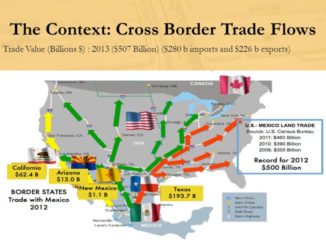
by Dick Startz
Presidential candidates are pushing for “free” community college for all; Douglas Harris described some of the early details here on the Chalkboard earlier this year. Greater access to community college is a clearly overdue policy for reasons we also talked about here in July, and it’s worth thinking through some of the details. (As an aside, some candidates propose four years of free college, others that college should be “debt-free.” We’ll leave discussion of those proposals for another day.) Currently, we have no national policy on community college attendance: States have very much gone their own ways. Policy diversity has some definite advantages. But things are so different across states that making community college free nationwide is going to be tough—implementation details are going to require some thought.
Here’s the first issue: Some states have chosen to go all in on community colleges, while other states do very little. Will this be a political problem? Will politicians from states with low community college attendance be reluctant to support subsidizing students in other states? Hopefully not, as states with low community college numbers today are also the states with the greatest likelihood of growing their attendance. What’s more, community college attendance doesn’t follow a simple red state/blue state pattern.
Right now (well, per the latest data from the Digest of Education Statistics in 2017), 22% of community college students are in California—which has 12% of the nation’s population. Another way to say this is that 33% of college-aged folk in California attend community college, as compared to a national average of 20%. Here’s a chart showing that same two-year school enrollment as a fraction of the college-aged population across states.
The other states that look something like California in this regard are pretty small in terms of population. (New Mexico and Wyoming actually have a higher ratio than California.) Texas, though, is a large state that is also well above the national average. Arizona, Iowa, and Virginia are also high. The state that stands out on the low end is Florida.
A complicating wrinkle in thinking about free community college is that the boundaries between community college and four-year schools are sometimes blurred. In some states, some bachelor’s degrees are offered by community colleges. (This may account for the low two-year enrollment reported for Florida.) Does that mean free tuition would not be covered in such schools? Or does it mean that a bachelor’s degree is covered if offered by a community college, but not if the same degree is offered in a “four-year school”? In some states, this is a big issue. In other states, the issue doesn’t arise. But it’s one more complication that will require careful thought and quite likely careful political negotiation.
A second issue is that states charge very, very different tuition levels. Compared to the status quo, very different subsidy levels will be needed across states to achieve zero-tuition nationwide. The national average annual tuition at public two-year colleges is $3,200. California is way below that. Texas is relatively low as well.
Here, too, the breakdown is not especially red versus blue, which probably helps with the politics. Nonetheless, some thought will be required to figure out how to cover tuition both in New Hampshire, where the current price tag is $7,300, and in California, which charges $1,300.
Some of the proposals for free tuition include a requirement for cost-sharing by states. States currently differ significantly in how much they spend per student, raising a third issue. I’ve calculated total expenditures on public two-year colleges and subtracted off tuition. The national annual average is $6,100. (Note: While I’m confident that states vary wildly in what they spend, don’t put too much weight on the numbers for a particular state. Also, the latest data is three years old, though that probably shouldn’t matter much.)
Mississippi spends almost $11,000 above tuition costs, while Virginia spends only $1,500. The situation is made more complicated by the fact that costs of real estate, construction, salaries, etc., vary so much across states. Simple formulas about cost-sharing may be difficult to reconcile with varying levels of existing contributions. (By the way, picking up the cost of tuition will increase total spending on community colleges by about a third, very roughly. Of course, free tuition will increase demand for community college—that’s kind of the idea, after all—which will further raise the required level of funding.)
Looking ahead, some thought should be given to how states will respond strategically to various proposals. For example, Joe Biden’s plan calls for “the federal government covering 75% of the cost and states contributing the remaining obligation.” (Fellow candidates Cory Booker, Kamala Harris, and Amy Klobuchar also call for free community college, while Bernie Sanders and Elizabeth Warren would extend free tuition to four-year public colleges as well.) Right now, California is a low-tuition, high-expenditure, high-participation state. Should California raise its $1,300 tuition to the $7,300 in Vermont— thus increasing tuition revenue—and then contribute a fourth of that ($1,825) to keep tuition free while the federal government contribute three-fourths ($5,475)? Students won’t care, since one government or another is picking up the tab. The extra revenue from Washington, D.C., would free up a lot of money that California is now using to subsidize its very large community college system.
The admirable goal of a federal program is to make community college available to Americans wherever they live. If that happens, we are likely to see community college within reach of a much greater number of students across the country. That will itself diminish the differences that exist today, but not on day one. Figuring out the details is going to require some good technocrats. And on the political side, there should be considerable appeal across both red and blue states. Perhaps this might be a good venue for bipartisan cooperation.
None of this is an argument against the federal government finding a way to make community college tuition-free. It is an argument that figuring out the details will take some work.
Dick Startz Professor of Economics – University of California, Santa Barbara
The Brown Center Chalkboard launched in January 2013 as a weekly series of new analyses of policy, research, and practice relevant to U.S. education.
In July 2015, the Chalkboard was re-launched as a Brookings blog in order to offer more frequent, timely, and diverse content. Contributors to both the original paper series and current blog are committed to bringing evidence to bear on the debates around education policy in America.
Read papers in the original Brown Center Chalkboard series »






